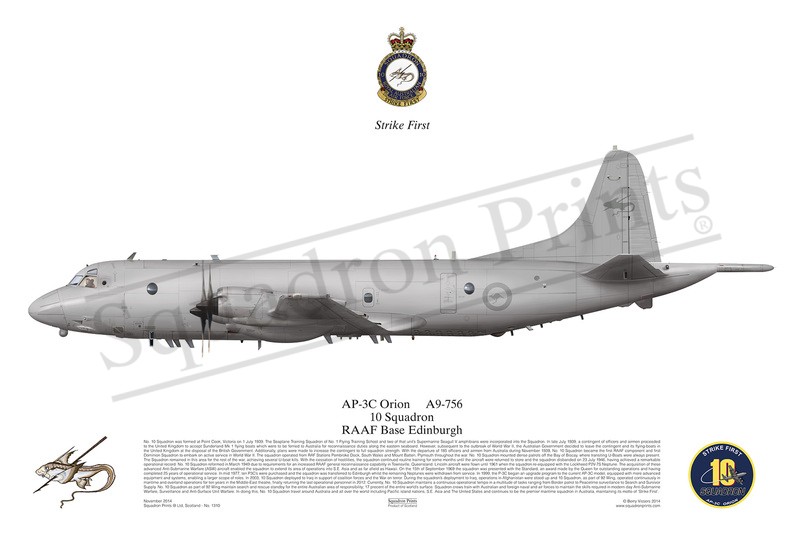#1310 AP-3C Orion

Purchased products will not feature the Squadron Prints watermark
Description
Squadron Prints Lithograph No. 13010 - AP-3C Orion, A9-756, 10 Squadron, RAAF Base Edinburgh.
No. 10 Squadron was formed at Point Cook, Victoria on 1 July 1939. The Seaplane Training Squadron of No. 1 Flying Training School and two of that unit’s Supermarine Seagull V amphibians were incorporated into the Squadron. In late July 1939, a contingent of officers and airmen proceeded to the United Kingdom to accept Sunderland Mk 1 flying boats which were to be ferried to Australia for reconnaissance duties along the eastern seaboard. However, subsequent to the outbreak of World War II, the Australian Government decided to leave the contingent and its flying-boats in the United Kingdom at the disposal of the British Government. Additionally, plans were made to increase the contingent to full squadron strength. With the departure of 185 officers and airmen from Australia during November 1939, No. 10 Squadron became the first RAAF component and first Dominion Squadron to embark on active service in World War II. The squadron operated from RAF Stations Pembroke Dock, South Wales and Mount Batten, Plymouth throughout the war. No. 10 Squadron mounted dense patrols off the Bay of Biscay, where transiting U-Boats were always present. The Squadron remained in this area for the rest of the war, achieving several U-boat kills. With the cessation of hostilities, the squadron continued routine training for some months until the aircraft were returned to store and the squadron disbanded on 23 July 1946, having achieved a remarkable operational record. No. 10 Squadron reformed in March 1949 due to requirements for an increased RAAF general reconnaissance capability in Townsville, Queensland. Lincoln aircraft were flown until 1961 when the squadron re-equipped with the Lockheed P2V-7S Neptune. The acquisition of these advanced Anti-Submarine Warfare (ASW) aircraft enabled the squadron to extend its area of operations into S.E. Asia and as far afield as Hawaii. On the 15th of September 1969 the squadron was presented with the Standard, an award made by the Queen for outstanding operations and having completed 25 years of operational service. In mid 1977, ten P3C’s were purchased and the squadron was transferred to Edinburgh whilst the remaining Neptunes were withdrawn from service. In 1999, the P-3C began an upgrade program to the current AP-3C model, equipped with more advanced equipment and systems, enabling a larger scope of roles. In 2003, 10 Squadron deployed to Iraq in support of coalition forces and the War on terror. During the squadron’s deployment to Iraq, operations in Afghanistan were stood up and 10 Squadron, as part of 92 Wing, operated continuously in maritime and overland operations for ten years in the Middle-East theatre, finally returning the last operational personnel in 2012. Currently, No. 10 Squadron maintains a continuous operational tempo in a multitude of tasks ranging from Border patrol to Peacetime surveillance to Search and Survivor Supply. No. 10 Squadron as part of 92 Wing maintain search and rescue standby for the entire Australian area of responsibility; 17 precent of the entire world’s surface. Squadron crews train with Australian and foreign naval and air forces to maintain the skills required in modern day Anti-Submarine Warfare, Surveillance and Anti-Surface Unit Warfare. In doing this, No. 10 Squadron travel around Australia and all over the world including Pacific island nations, S.E. Asia and The United States and continues to be the premier maritime squadron in Australia, maintaining its motto of ‘Strike First’.
